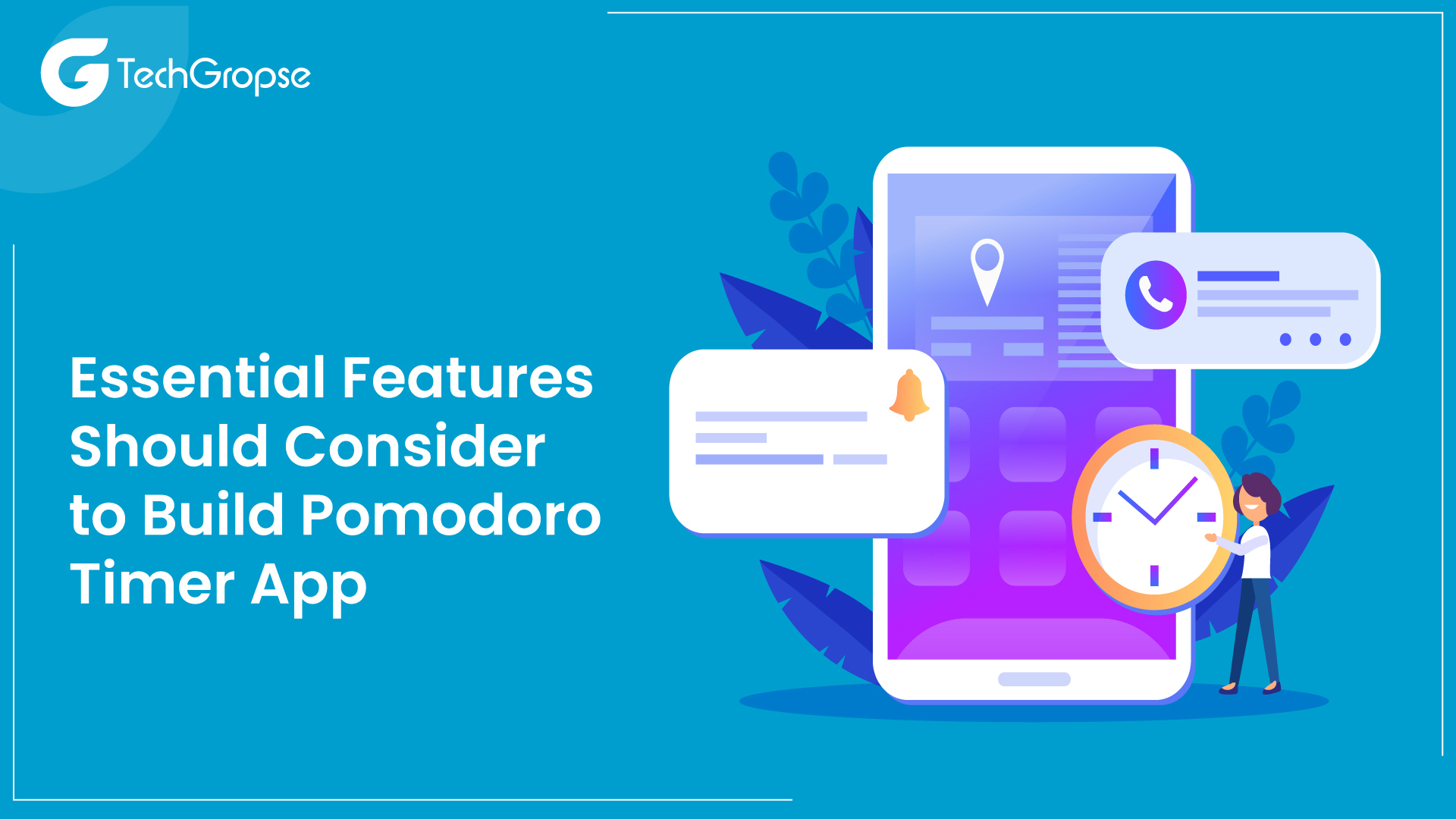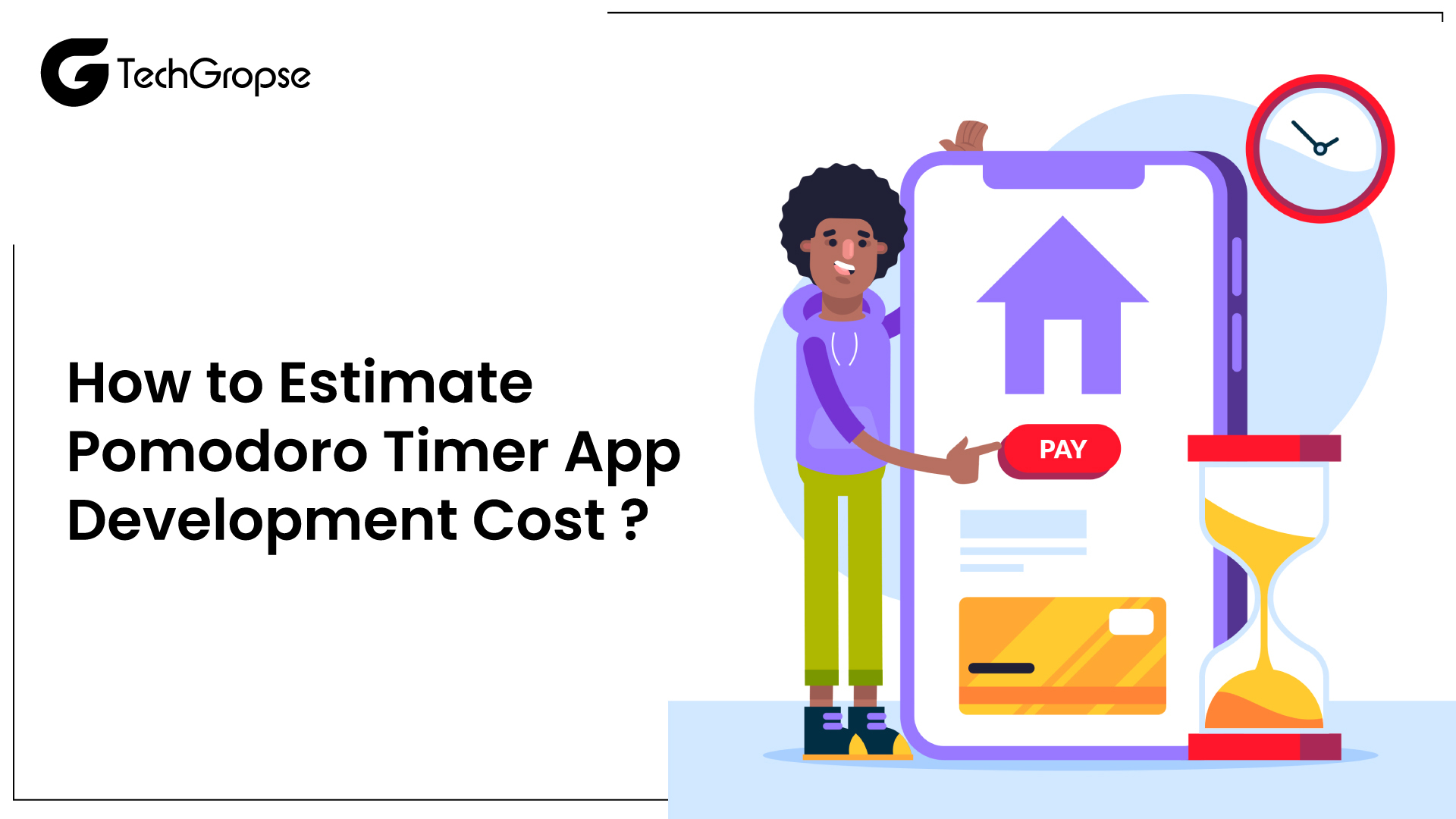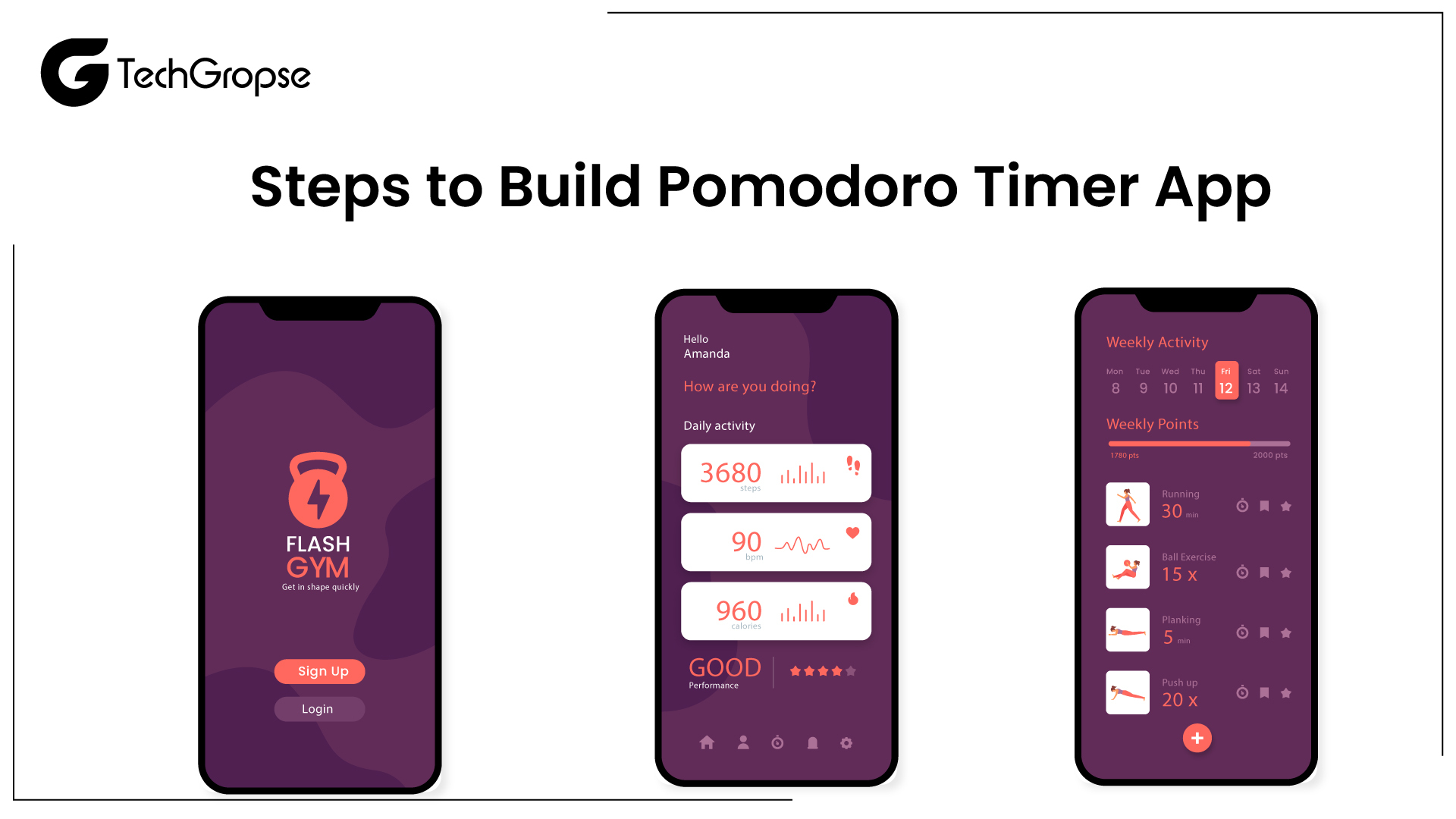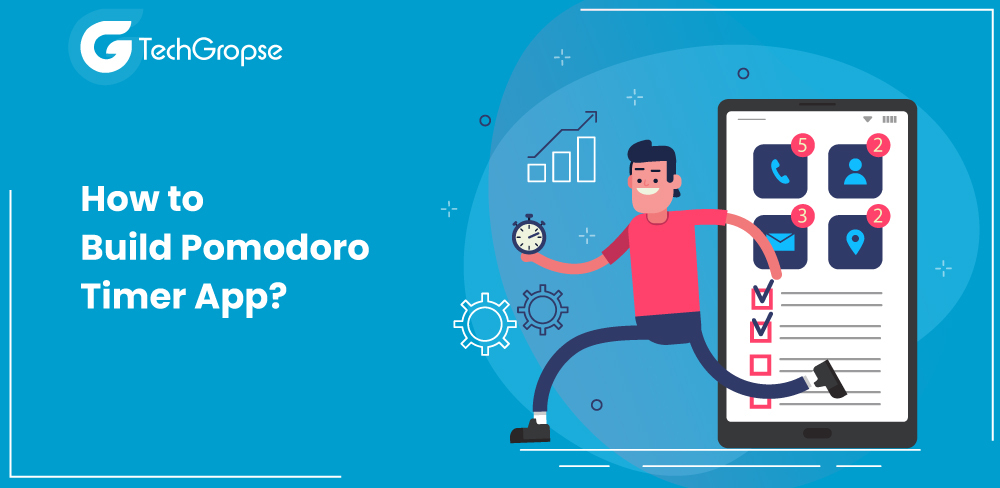If you have ever struggled with productivity or time management, then you may have heard of the Pomodoro Technique. This time management method splits work periods into 25-minute intervals, or “Pomodoros,” with short breaks in between. While you might use a timer or stopwatch to execute this technique on your own, build Pomodoro timer app, can offer added benefits, like customization options and notifications.
On-demand app development company focuses to build a Pomodoro timer app, you have to choose a programming language and framework, plan, design the amazing app’s features, and code the timer and break functionalities.
You will also need to implement notifications to alert the user when to start a new Pomodoro or take a break, and allow the user to track their completed Pomodoros. Once you have developed and tested the app, you can deploy it to a web server or app store.
In this guide, we will outline the steps to building your own Pomodoro Timer app, from planning and design to testing and launching.
What is Pomodoro Timer App?
The Pomodoro Technique was designed by Francesco Cirillo in the late 1980s, and it involves working for 25 minutes, then taking a 5-minute break, before recounting the cycle. The app is named after the tomato-shaped kitchen timer that Cirillo used to time his work intervals.
Using a Pomodoro Timer app can help you stay on track and maintain focus while working. The app keeps track of the Pomodoro intervals and alerts you when it’s time for a break or when the work period is over.
- Start a 25-minute timer
- Work until the timer rings.
- Take a 5 minutes break.
- Every four Pomodoros, take a break (15 minutes).
It can also help you track your progress over time and identify areas where you must improve. Apart from that, some Pomodoro Timer apps come with additional features such as task lists and productivity tracking, making them a valuable tool for anyone looking to boost their productivity.
What is the 52-17 Rule Vs Pomodoro?
The 52-17 rule is a time management technique similar to the Pomodoro Technique but with longer work periods and longer breaks. The 52-17 rule applies working for 52 minutes followed by a 17-minute break.
However, both techniques aim to enhance productivity and focus by breaking work into intervals and taking regular breaks, they vary in the length of work periods and breaks. The Pomodoro Technique uses 25-minute work periods and 5-minute breaks, on the other hand, the 52-17 rule uses 52-minute work periods and 17-minute breaks.
The 52-17 rule may work better for individuals who can maintain focus for longer periods of time, while the Pomodoro Technique may be more effective for those who choose shorter work periods and more frequent breaks.
Ultimately, the effectiveness of a time management technique depends on the individual and their work style, and it may take some experimentation to find the best method for each person.
Related reading: custom software development cost in 2025
Essential Features Should Consider to Build Pomodoro Timer App

The Pomodoro Timer app is a productivity tool designed to help individuals break down their work into focused intervals. If you want to build Pomodoro app you must consider the key features of this app including the classic Pomodoro technique:
- Timer: The timer is the most essential feature of a Pomodoro timer app. It should allow the user to set the work and break periods, and it should show a countdown of the remaining time.
- Customization: The Pomodoro timer app development company includes interesting features. The app should allow users to customize the work and break periods according to their preferences.
- Sound & Notifications: A Pomodoro timer app can offer various sound and notification options to signal the start and end of work and break periods. Some users may prefer a gentle chime or beep, while others may use a more jarring alarm. The app should allow the user to select the type of sound and notification that best suits their requirements.
- Tracking: The app should track the number of pomodoros completed, the time spent on every task, and the number of breaks taken.
- Goals: A Pomodoro timer app can allow users to set goals and track their progress toward those goals. For example, a user may want to complete a specific number of Pomodoro sessions per day or per week. The app can deliver a progress tracker to help the user stay on track and motivated.
- Reports: The app should generate reports that show the user’s productivity and progress toward their goals.
- Integrations: A Pomodoro timer app can be integrated with other apps like task managers or calendar apps, to offer a more streamlined workflow. For example, the app can automatically create a task in the user’s task manager when a Pomodoro session starts, or add a reminder to their calendar when a break period is about to end.
- User Interface: A Pomodoro timer app can be customized to suit the user’s preferences in terms of layout, colors, and other visual elements. A well-designed user interface can create the app more enjoyable to use and help the user stay focused and engaged.
- Sound and Vibration: The app should have sound and vibration options for notifications to ensure the user is aware when the timer has ended.
- Device Compatibility: The app must be compatible with different devices, such as desktops, laptops, and smartphones, to increase its accessibility.
By offering a range of customizable features, a Pomodoro timer app can be tailored to suit the user’s requirements and preferences, making it a more effective productivity tool.
How do You Code Pomodoro Technique?

To build Pomodoro timer app, the Android app development company uses various programming languages and frameworks depending on your preference and platform.
Here is a simple algorithm for building a Pomodoro timer app:
- Create a user interface that includes a timer display and buttons to start, pause, and reset the timer.
- Allow the user to set the work and break periods using input fields or sliders.
- When the user clicks the start button, start the timer countdown for the work period.
- When the work period is over, play a sound and display a notification to signal the start of the break period.
- When the break period is over, play a sound and display a notification to signal the start of the next work period.
- Keep track of the number of Pomodoros completed, and display it in the UI.
- Provide options for the user to customize the sounds and notification settings.
Here’s a basic implementation of the algorithm in Python using the Tkinter library for the user interface:
import tkinter as tk
import time
class PomodoroTimer:
def __init__(self, work_time=25, break_time=5):
self.root = tk.Tk()
self.root.title("Pomodoro Timer")
self.work_time = work_time * 60
self.break_time = break_time * 60
self.current_time = self.work_time
self.pomodoros_completed = 0
# create timer label
self.timer_label = tk.Label(self.root, text="25:00", font=("Arial", 32))
self.timer_label.pack(pady=10)
# create start button
self.start_button = tk.Button(self.root, text="Start", command=self.start_timer)
self.start_button.pack()
# create reset button
self.reset_button = tk.Button(self.root, text="Reset", command=self.reset_timer, state=tk.DISABLED)
self.reset_button.pack()
# run the main loop
self.root.mainloop()
def start_timer(self):
self.start_button.config(state=tk.DISABLED)
self.reset_button.config(state=tk.NORMAL)
while self.current_time > 0:
minutes = self.current_time // 60
seconds = self.current_time % 60
self.timer_label.config(text="{:02d}:{:02d}".format(minutes, seconds))
self.root.update()
time.sleep(1)
self.current_time -= 1
if self.current_time == 0:
self.pomodoros_completed += 1
if self.pomodoros_completed % 4 == 0:
self.current_time = self.break_time
tk.messagebox.showinfo("Break Time!", "Time for a longer break!")
else:
self.current_time = self.work_time
tk.messagebox.showinfo("Work Time!", "Time to get back to work!")
self.start_timer()
def reset_timer(self):
self.start_button.config(state=tk.NORMAL)
self.reset_button.config(state=tk.DISABLED)
self.current_time = self.work_time
self.timer_label.config(text="25:00")
This code makes a basic user interface using the Tkinter library and implements a timer that counts down from 25 minutes for the work period and 5 minutes for the break period.
The timer updates every second and plays a sound and displays a notification when the work or break period ends. The user can reset the timer or start a new Pomodoro session.
Related reading: custom software development cost in 2025
Advantages to Build Pomodoro Timer App
There are several advantages to building a Pomodoro timer app, including
1. Increased productivity
The Pomodoro Technique is a proven productivity strategy that helps users stay focused and achieve more in less time. To build a Pomodoro timer app, you can help users remain on track and enhance their productivity.
2. Customization
A Pomodoro timer app can be customized to suit the user’s specific requirements and preferences. For example, users can set work and break periods, choose various sounds and notifications, and track their progress toward their goals.
3. Accessibility
A Pomodoro timer app can be accessed on numerous devices, including desktops, laptops, and smartphones, making it easy for users to use it wherever they are.
4. Cost-effective
Building a Pomodoro timer app is a cost-effective way to improve productivity compared to other productivity tools that may require a subscription fee.
5. Easy to use
A Pomodoro timer app is simple to use and requires minimal training, making it an accessible productivity tool for anyone to use.
6. Development Experience
Developing a Pomodoro timer app can be a great way to gain experience in programming and software development. The project can be used to learn new programming languages, libraries, and frameworks and can be used to build a portfolio of work to showcase to potential employers.
Overall, building a Pomodoro timer app can be an excellent way to improve productivity, gain programming experience, and create a useful tool that can benefit many users.
Steps to Build Pomodoro Timer App

Pomodoro timer app development company follows all the essential steps to build a Pomodoro timer app, you can follow these general steps:
1. Plan and Design
Start by defining the features you want in your Pomodoro apps like customizable timer length, breaks, notifications, and tracking of completed Pomodoros. Build a basic wireframe or mockup of the app’s user interface and the screens that you will require.
2. Choose a programming language and framework
There are some programming languages and frameworks you can use to build Pomodoro timer app. Some popular options include Python, JavaScript, React, and Angular. Choose a language and framework that you are comfortable with and that suits your app’s requirements.
3. Develop the Timer
Start by coding the timer functionality. The timer should be able to countdown the Pomodoro duration and alert the user when the Pomodoro is done. You can use JavaScript’s built-in `setTimeout()` and `setInterval()` functions to create the timer.
4. Implement Breaks
Once the Pomodoro duration is over, implement the break feature. The break should also be customizable and alert the user when it is complete.
5. Track Completed Pomodoros
You can add a feature that enables the user to track their completed Pomodoros. This feature could include a Pomodoro counter or a chart that displays their progress over time.
6. Test and Debug
Once you have developed the core features of your Pomodoro timer app, test it thoroughly to ensure that it is functioning correctly. You must hire dedicated developers to debug any errors or issues that you find. Test the app on various devices and operating systems to ensure it works correctly and is user-friendly. Integrate analytics and error reporting features to monitor the performance and identify potential issues.
7. Deploy the App
After testing and debugging, deploy the app to a web server or a cloud platform like Heroku, Netlify, or AWS. You can also publish the app to an app store for iOS or Android devices. Develop a marketing strategy to promote the app, create social media profiles, and reach out to potential users.
Remember to keep your app simple and user-friendly, with a clean and minimalistic interface.
How to Estimate Pomodoro Timer App Development Cost
The Pomodoro timer app development cost can depend on several factors, including the app’s complexity, the development platform, and the features and functionality required.
Here are some factors to consider when calculating the cost of developing a Pomodoro timer app:
- Platform: The cost of developing a Pomodoro timer app can vary depending on the platform it will be created for, such as iOS, Android, or web. Developing an app for numerous platforms can raise the cost.
- Features: The cost of developing a Pomodoro timer app can depend on the features and functionality required. For example, a basic Pomodoro timer app may have simple features like a timer and sound notifications, while a more complex app may include features like goal tracking, integration with other apps, and customization options.
- Design: The cost of developing a Pomodoro timer app can also depend on the design requirements. A well-designed app with a visually appealing user interface can increase the cost of development.
- Development team: The cost of development can vary depending on the development team’s experience and location. A company must hire mobile app developers from a higher-cost location can increase the cost while hiring a less experienced team from a lower-cost location can reduce the cost.
Based on the above aspects, the cost of developing a basic Pomodoro timer app can range from some thousand dollars to tens of thousands of dollars, while a more complex app with advanced features can cost upwards of $50,000 or more. It is essential to work with a development team to discuss the specific needs of the app and get an accurate estimate of the cost of development.
Best Pomodoro Apps to Keep You Focused in 2023
Pomodoro apps can offer to track and give you a way to see your progress at anytime time. Here are some of the best Pomodoro apps available to help you track your time and enhance your productivity:
| S. No. | Application Name | Format | Price |
| 1 | ClickUp | Web, macOS, Android, Windows, iOS, mobile app | Paid plans start from $5 per user/ month |
| 2 | Focus | iOS and MacOS | Monthly at $4.99/ month
Yearly at $39.99/ year
|
| 3 | Focus Keeper | App available for iOS | ● Free
● $2 for the pro plan |
| 4 | Marinara Timer | Web | Free |
| 5 | Toggl | Web, iOS, Android | ● Free for up to 5 users
● Starter plan: $9 per user per month ● Premium plan: $18 per user per month |
| 6 | Forest | iOS, Android, Google Chrome | $2 for iOS and Google Play, or free as a Chrome extension |
The Bottom Line
By following the steps outlined in this guide, you can create a functional and customizable Pomodoro Timer app to help you improve your productivity and time management skills. Whether you use the app for personal or professional purposes, integrating the Pomodoro Technique into your routine can help you stay focused and accomplish your goals.
So, get started on building your own Pomodoro Timer app today!
FAQ: How to Build Pomodoro Timer App
1. How to make a Pomodoro website
The Pomodoro Timer app is a productivity tool designed to help people break down their work into focused intervals. Key features of this app include the classic Pomodoro technique, which involves working for 25 minutes followed by a 5-minute break; customizable timers to adjust work and break intervals according to individual preferences; the ability to track progress by recording completed cycles and tasks; and the option to set daily goals for increased motivation.
2. Do I need to have experience in coding to build a Pomodoro Timer app?
While some coding experience can help, it is not necessary to build a Pomodoro Timer app. There are tools and resources available, such as app builders and tutorials, that can guide you through the process.
3. What platforms can I build a Pomodoro Timer app for?
You can build a Pomodoro Timer app for various platforms, such as web, mobile, and desktop. The technology stack you choose will depend on the platform you want to build the app for.









